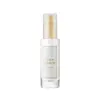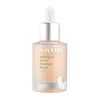What's inside
What's inside
 Key Ingredients
Key Ingredients

 Benefits
Benefits

 Concerns
Concerns

No concerns
 Ingredients Side-by-side
Ingredients Side-by-side

Aspergillus/Rice Germ Ferment Extract Filtrate 73%
EmollientPropanediol
SolventGlycerin
HumectantMethylpropanediol
SolventCyclopentasiloxane
EmollientNiacinamide
SmoothingCaprylyl Methicone
Skin ConditioningWater
Skin ConditioningCyclohexasiloxane
Emollient1,2-Hexanediol
Skin ConditioningSqualane
EmollientBetaine
HumectantC12-14 Pareth-12
EmulsifyingAmmonium Acryloyldimethyltaurate/Vp Copolymer
Panthenol
Skin ConditioningC30-45 Alkyl Cetearyl Dimethicone Crosspolymer
EmollientEthylhexylglycerin
Skin ConditioningAllantoin
Skin ConditioningXanthan Gum
EmulsifyingDipotassium Glycyrrhizate
HumectantAdenosine
Skin ConditioningDisodium EDTA
Pentylene Glycol
Skin ConditioningHydrolyzed Hyaluronic Acid
HumectantAlpha-Glucan Oligosaccharide
CleansingSodium Hyaluronate
HumectantMadecassoside
AntioxidantPortulaca Oleracea Extract
Skin ConditioningHydroxypropyl Cyclodextrin
MaskingGlutathione
Aspergillus/Rice Germ Ferment Extract Filtrate 73%, Propanediol, Glycerin, Methylpropanediol, Cyclopentasiloxane, Niacinamide, Caprylyl Methicone, Water, Cyclohexasiloxane, 1,2-Hexanediol, Squalane, Betaine, C12-14 Pareth-12, Ammonium Acryloyldimethyltaurate/Vp Copolymer, Panthenol, C30-45 Alkyl Cetearyl Dimethicone Crosspolymer, Ethylhexylglycerin, Allantoin, Xanthan Gum, Dipotassium Glycyrrhizate, Adenosine, Disodium EDTA, Pentylene Glycol, Hydrolyzed Hyaluronic Acid, Alpha-Glucan Oligosaccharide, Sodium Hyaluronate, Madecassoside, Portulaca Oleracea Extract, Hydroxypropyl Cyclodextrin, Glutathione
Water
Skin ConditioningNelumbo Nucifera Germ Extract
Skin ConditioningCyclopentasiloxane
EmollientButylene Glycol
HumectantNiacinamide
SmoothingDimethicone
Emollient1,2-Hexanediol
Skin ConditioningBetaine
HumectantCyclohexasiloxane
EmollientGlycerin
HumectantSodium Acrylate/Sodium Acryloyldimethyl Taurate Copolymer
Emulsion StabilisingMethyl Gluceth-20
HumectantDimethicone/Vinyl Dimethicone Crosspolymer
Skin ConditioningIsohexadecane
EmollientDimethiconol
EmollientAcrylates/C10-30 Alkyl Acrylate Crosspolymer
Emulsion StabilisingTromethamine
BufferingPolysorbate 80
EmulsifyingParfum
MaskingSodium Phytate
Ethylhexylglycerin
Skin ConditioningAdenosine
Skin ConditioningXanthan Gum
EmulsifyingSorbitan Oleate
EmulsifyingMadecassoside
AntioxidantFerulic Acid
AntimicrobialCentella Asiatica Leaf Extract
Skin ConditioningBeta-Glucan
Skin ConditioningSclerotium Gum
Emulsion StabilisingAsiaticoside
AntioxidantDextrin
AbsorbentTheobroma Cacao Extract
Skin ConditioningArginine
MaskingCysteine
AntioxidantEctoin
Skin ConditioningGlutamine
Skin ConditioningGlycine
BufferingHistidine
HumectantHyaluronic Acid
HumectantInositol
HumectantLysine
Skin ConditioningPentylene Glycol
Skin ConditioningRaffinose
Skin ConditioningSodium Hyaluronate
HumectantBrassica Campestris Sprout Extract
HumectantBrassica Oleracea Italica Sprout Extract
EmollientSophora Japonica Bud Extract
Skin ProtectingTriticum Vulgare Sprout Extract
Skin ConditioningCaprylyl Glycol
EmollientLimonene
PerfumingHexyl Cinnamal
PerfumingLinalool
PerfumingGeraniol
PerfumingWater, Nelumbo Nucifera Germ Extract, Cyclopentasiloxane, Butylene Glycol, Niacinamide, Dimethicone, 1,2-Hexanediol, Betaine, Cyclohexasiloxane, Glycerin, Sodium Acrylate/Sodium Acryloyldimethyl Taurate Copolymer, Methyl Gluceth-20, Dimethicone/Vinyl Dimethicone Crosspolymer, Isohexadecane, Dimethiconol, Acrylates/C10-30 Alkyl Acrylate Crosspolymer, Tromethamine, Polysorbate 80, Parfum, Sodium Phytate, Ethylhexylglycerin, Adenosine, Xanthan Gum, Sorbitan Oleate, Madecassoside, Ferulic Acid, Centella Asiatica Leaf Extract, Beta-Glucan, Sclerotium Gum, Asiaticoside, Dextrin, Theobroma Cacao Extract, Arginine, Cysteine, Ectoin, Glutamine, Glycine, Histidine, Hyaluronic Acid, Inositol, Lysine, Pentylene Glycol, Raffinose, Sodium Hyaluronate, Brassica Campestris Sprout Extract, Brassica Oleracea Italica Sprout Extract, Sophora Japonica Bud Extract, Triticum Vulgare Sprout Extract, Caprylyl Glycol, Limonene, Hexyl Cinnamal, Linalool, Geraniol
 Reviews
Reviews

Ingredients Explained
These ingredients are found in both products.
Ingredients higher up in an ingredient list are typically present in a larger amount.
1,2-Hexanediol is a synthetic liquid and another multi-functional powerhouse.
It is a:
- Humectant, drawing moisture into the skin
- Emollient, helping to soften skin
- Solvent, dispersing and stabilizing formulas
- Preservative booster, enhancing the antimicrobial activity of other preservatives
Adenosine is in every living organism. It is one of four components in nucleic acids that helps store our DNA.
Adenosine has many benefits when used. These benefits include hydrating the skin, smoothing skin, and reducing wrinkles. Once applied, adenosine increases collagen production. It also helps with improving firmness and tissue repair.
Studies have found adenosine may also help with wound healing.
In skincare products, Adenosine is usually derived from yeast.
Learn more about AdenosineBetaine is a common humectant (a substance that promotes retention of moisture). It's known to be gentle on the skin and can help balance hydration.
This ingredient is best for improving hydration and soothing irritated skin. Studies also show it helps even out skin tone.
Fun fact: Betaine is naturally created in the skin and body. The kind found within cosmetic products can be either plant-derived or synthetic.
Another name for betaine is trimethylglycine.
Learn more about BetaineCyclohexasiloxane is a type of silicone more commonly known as D6. It is an emollient and solvent.
Cyclohexasiloxane is used to evenly distribute ingredients throughout the product. When applied to the skin, Cyclohexasiloxane evaporates and leaves behind a silky feel.
As an emollient, it can help the skin feel soft and hydrated. It is also used to reduce frizz in hair products.
Learn more about CyclohexasiloxaneCyclopentasiloxane, or D5, is a silicone used to improve texture of products and trap moisture.
D5 is considered lightweight and volatile. Volatile means it evaporates quickly after application. Once evaporated, D5 leaves a thin barrier that helps keep skin hydrated.
It is also an emollient. Emollients help soften the skin and prevent water loss. Silicones create a silky texture in products. D5 helps other ingredients become more spreadable.
Studies show D5 is safe to use in skincare products. We recommend speaking with a skincare professional if you have concerns.
Learn more about CyclopentasiloxaneEthylhexylglycerin (we can't pronounce this either) is commonly used as a preservative and skin softener. It is derived from glyceryl.
You might see Ethylhexylglycerin often paired with other preservatives such as phenoxyethanol. Ethylhexylglycerin has been found to increase the effectiveness of these other preservatives.
Glycerin is already naturally found in your skin. It helps moisturize and protect your skin.
A study from 2016 found glycerin to be more effective as a humectant than AHAs and hyaluronic acid.
As a humectant, it helps the skin stay hydrated by pulling moisture to your skin. The low molecular weight of glycerin allows it to pull moisture into the deeper layers of your skin.
Hydrated skin improves your skin barrier; Your skin barrier helps protect against irritants and bacteria.
Glycerin has also been found to have antimicrobial and antiviral properties. Due to these properties, glycerin is often used in wound and burn treatments.
In cosmetics, glycerin is usually derived from plants such as soybean or palm. However, it can also be sourced from animals, such as tallow or animal fat.
This ingredient is organic, colorless, odorless, and non-toxic.
Glycerin is the name for this ingredient in American English. British English uses Glycerol/Glycerine.
Learn more about GlycerinMadecassoside comes from the super popular skin-soothing ingredient, Centella asiatica. It is one of four active compounds found in the extract of Centella Asiatica.
Madecassoside has antioxidant, anti-inflammatory, and hydrating properties. It contains fatty acids, amino acids, beta-carotene, and phytochemicals.
One study found using Madecassoside with ascorbic acid helped reduce the signs of aging and improved skin hydration.
Learn more about MadecassosideNiacinamide is a multitasking form of vitamin B3 that strengthens the skin barrier, reduces pores and dark spots, regulates oil, and improves signs of aging.
And the best part? It's gentle and well-tolerated by most skin types, including sensitive and reactive skin.
You might have heard of "niacin flush", or the reddening of skin that causes itchiness. Niacinamide has not been found to cause this.
In very rare cases, some individuals may not be able to tolerate niacinamide at all or experience an allergic reaction to it.
If you are experiencing flaking, irritation, and dryness with this ingredient, be sure to double check all your products as this ingredient can be found in all categories of skincare.
When incorporating niacinamide into your routine, look out for concentration amounts. Typically, 5% niacinamide provides benefits such as fading dark spots. However, if you have sensitive skin, it is better to begin with a smaller concentration.
When you apply niacinamide to your skin, your body converts it into nicotinamide adenine dinucleotide (NAD). NAD is an essential coenzyme that is already found in your cells as "fuel" and powers countless biological processes.
In your skin, NAD helps repair cell damage, produce new healthy cells, support collagen production, strengthen the skin barrier, and fight environmental stressors (like UV and pollution).
Our natural NAD levels start to decline with age, leading to slower skin repair, visible aging, and a weaker skin barrier. By providing your skin niacinamide, you're recharging your skin's NAD levels. This leads to stronger, healthier, and younger looking skin.
Another name for vitamin B3 is nicotinamide. This vitamin is water-soluble and our bodies don't store it. We obtain Vitamin B3 from either food or skincare. Meat, fish, wheat, yeast, and leafy greens contain vitamin B3.
The type of niacinamide used in skincare is synthetically created.
Learn more about NiacinamidePentylene glycol is typically used within a product to thicken it. It also adds a smooth, soft, and moisturizing feel to the product. It is naturally found in plants such as sugar beets.
The hydrophilic trait of Pentylene Glycol makes it a humectant. As a humectant, Pentylene Glycol helps draw moisture from the air to your skin. This can help keep your skin hydrated.
This property also makes Pentylene Glycol a great texture enhancer. It can also help thicken or stabilize a product.
Pentylene Glycol also acts as a mild preservative and helps to keep a product microbe-free.
Some people may experience mild eye and skin irritation from Pentylene Glycol. We always recommend speaking with a professional about using this ingredient in your routine.
Pentylene Glycol has a low molecular weight and is part of the 1,2-glycol family.
Learn more about Pentylene GlycolSodium Hyaluronate is hyaluronic acid's salt form. It is commonly derived from the sodium salt of hyaluronic acid.
Like hyaluronic acid, it is great at holding water and acts as a humectant. This makes it a great skin hydrating ingredient.
Sodium Hyaluronate is naturally occurring in our bodies and is mostly found in eye fluid and joints.
These are some other common types of Hyaluronic Acid:
Learn more about Sodium HyaluronateWater. It's the most common cosmetic ingredient of all. You'll usually see it at the top of ingredient lists, meaning that it makes up the largest part of the product.
So why is it so popular? Water most often acts as a solvent - this means that it helps dissolve other ingredients into the formulation.
You'll also recognize water as that liquid we all need to stay alive. If you see this, drink a glass of water. Stay hydrated!
Learn more about WaterXanthan gum is used as a stabilizer and thickener within cosmetic products. It helps give products a sticky, thick feeling - preventing them from being too runny.
On the technical side of things, xanthan gum is a polysaccharide - a combination consisting of multiple sugar molecules bonded together.
Xanthan gum is a pretty common and great ingredient. It is a natural, non-toxic, non-irritating ingredient that is also commonly used in food products.
Learn more about Xanthan Gum